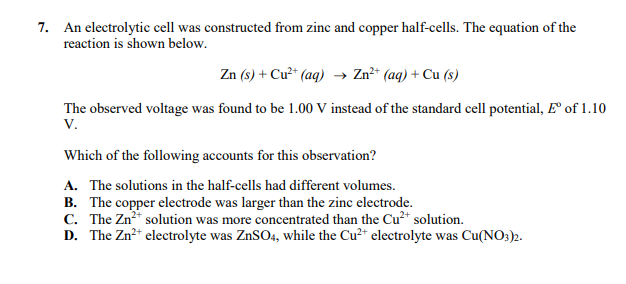7. An electrolytic cell was constructed from zinc and copper half-cells. The equation of the reaction is shown below. Zn (s) + Cư“ (aq) → Zn²* (aq) + Cu (s) The observed voltage was found to be 1.00 V instead of the standard cell potential, F of 1.10 V. Which of the following accounts for this observation? A. The solutions in the half-cells had different volumes. B. The copper electrode was larger than the zinc electrode. C. The Zn* solution was more concentrated than the Cu²* solution. D. The Zn2* electrolyte was ZnSO4, while the Cu²* electrolyte was Cu(NO:)2-
7. An electrolytic cell was constructed from zinc and copper half-cells. The equation of the reaction is shown below. Zn (s) + Cư“ (aq) → Zn²* (aq) + Cu (s) The observed voltage was found to be 1.00 V instead of the standard cell potential, F of 1.10 V. Which of the following accounts for this observation? A. The solutions in the half-cells had different volumes. B. The copper electrode was larger than the zinc electrode. C. The Zn* solution was more concentrated than the Cu²* solution. D. The Zn2* electrolyte was ZnSO4, while the Cu²* electrolyte was Cu(NO:)2-
Chemistry & Chemical Reactivity
10th Edition
ISBN:9781337399074
Author:John C. Kotz, Paul M. Treichel, John Townsend, David Treichel
Publisher:John C. Kotz, Paul M. Treichel, John Townsend, David Treichel
Chapter19: Principles Of Chemical Reactivity: Electron Transfer Reactions
Section: Chapter Questions
Problem 94GQ: A voltaic cell is constructed in which one half-cell consists of a silver wire in an aqueous...
Related questions
Question
Q7
Thanks For Your Help ! :D

Transcribed Image Text:7. An electrolytic cell was constructed from zinc and copper half-cells. The equation of the
reaction is shown below.
Zn (s) + Cu²* (aq) → Zn²* (aq) + Cu (s)
The observed voltage was found to be 1.00 V instead of the standard cell potential, F of 1.10
V.
Which of the following accounts for this observation?
A. The solutions in the half-cells had different volumes.
B. The copper electrode was larger than the zinc electrode.
C. The Zn solution was more concentrated than the Cu²* solution.
D. The Zn* electrolyte was ZnSO4, while the Cu2* electrolyte was Cu(NO3)2.
Expert Solution
This question has been solved!
Explore an expertly crafted, step-by-step solution for a thorough understanding of key concepts.
This is a popular solution!
Trending now
This is a popular solution!
Step by step
Solved in 4 steps with 3 images

Knowledge Booster
Learn more about
Need a deep-dive on the concept behind this application? Look no further. Learn more about this topic, chemistry and related others by exploring similar questions and additional content below.Recommended textbooks for you

Chemistry & Chemical Reactivity
Chemistry
ISBN:
9781337399074
Author:
John C. Kotz, Paul M. Treichel, John Townsend, David Treichel
Publisher:
Cengage Learning

Chemistry & Chemical Reactivity
Chemistry
ISBN:
9781133949640
Author:
John C. Kotz, Paul M. Treichel, John Townsend, David Treichel
Publisher:
Cengage Learning

Principles of Modern Chemistry
Chemistry
ISBN:
9781305079113
Author:
David W. Oxtoby, H. Pat Gillis, Laurie J. Butler
Publisher:
Cengage Learning

Chemistry & Chemical Reactivity
Chemistry
ISBN:
9781337399074
Author:
John C. Kotz, Paul M. Treichel, John Townsend, David Treichel
Publisher:
Cengage Learning

Chemistry & Chemical Reactivity
Chemistry
ISBN:
9781133949640
Author:
John C. Kotz, Paul M. Treichel, John Townsend, David Treichel
Publisher:
Cengage Learning

Principles of Modern Chemistry
Chemistry
ISBN:
9781305079113
Author:
David W. Oxtoby, H. Pat Gillis, Laurie J. Butler
Publisher:
Cengage Learning

General Chemistry - Standalone book (MindTap Cour…
Chemistry
ISBN:
9781305580343
Author:
Steven D. Gammon, Ebbing, Darrell Ebbing, Steven D., Darrell; Gammon, Darrell Ebbing; Steven D. Gammon, Darrell D.; Gammon, Ebbing; Steven D. Gammon; Darrell
Publisher:
Cengage Learning


Chemistry
Chemistry
ISBN:
9781305957404
Author:
Steven S. Zumdahl, Susan A. Zumdahl, Donald J. DeCoste
Publisher:
Cengage Learning